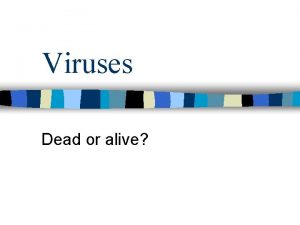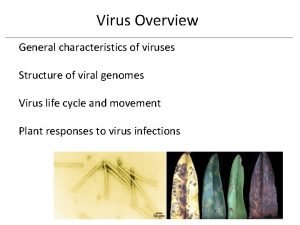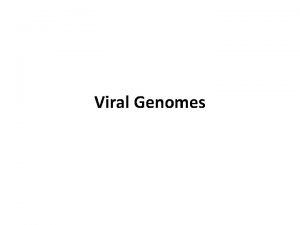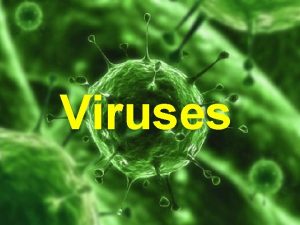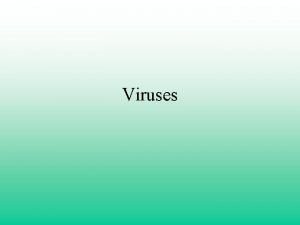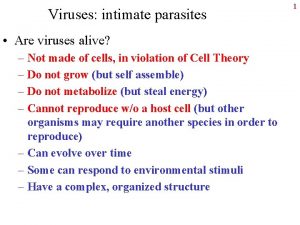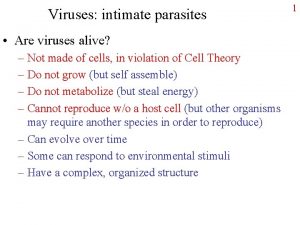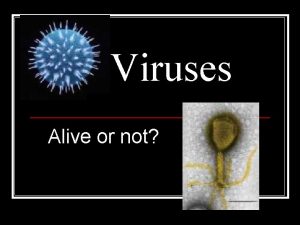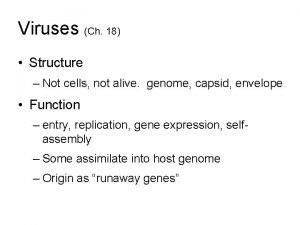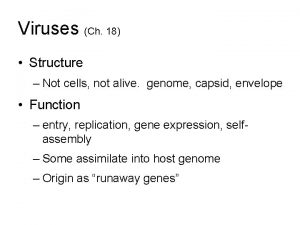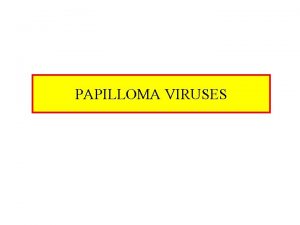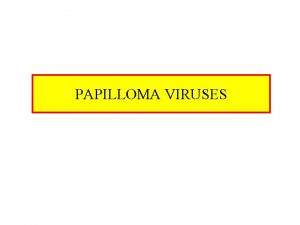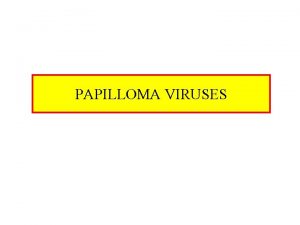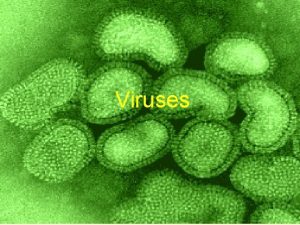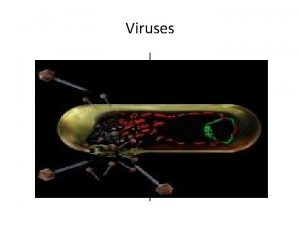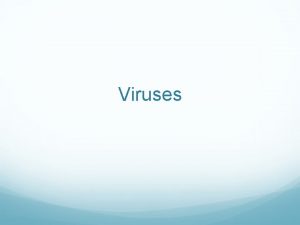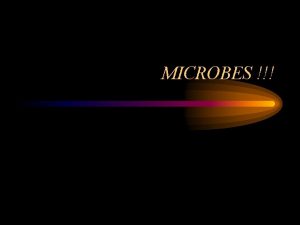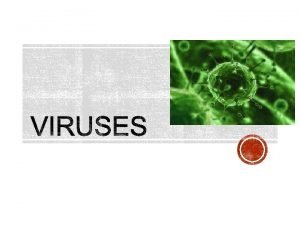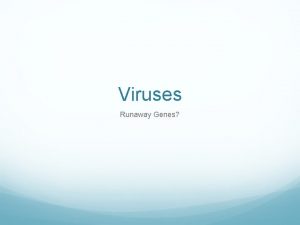Viruses Characteristics of Viruses Viruses are NOT alive





























- Slides: 29

Viruses

Characteristics of Viruses • • Viruses are NOT alive They do not have a cytoplasm or organelles Cannot carry out cellular functions They do not divide (reproduce) outside host cell

Viral Size and Structure • Viruses are super small! • The shape of a virus is the result of its genome and protein coat – capsid • Some viruses have a bilipid membrane called an envelope that surrounds the capsid


Classification of Viruses • Viruses can be classified by: – if the have RNA or DNA – If genome is single stranded or double stranded – The nature of their capsid – Presence or absence of envelope Example: SARS is a single-stranded, linear RNA and envelope virus with lollipop-shaped proteins that make the envelope look like a crown

Viral Replication • Viruses need a host cell! • They can spread from host to host through the air, water, food, or bodily fluids (yuck) • Viruses infect both prokaryotes AND eukaryotes

Viral Replication • Viruses need to recognize a proper host cell before they can infect it. • Viruses are obligate intercellular parasites – they replicate only by using host cell enzymes and organelles to make more viruses

Viral Replication Pathway “lock-and-key” fit between proteins and receptor molecules of host cells A viral infection begins when a virus enters the host cell. The viral genome takes over the metabolic machinery of the cell and makes new viruses

Replication in DNA Viruses • When DNA viruses enter a host cell, it makes m. RNA, which is the template for making proteins • Other DNA viruses insert their DNA into the host cell’s chromosome – This inserted viral DNA is known as a provirus – The host cell’s enzymes then transcribe the provirus into m. RNA and create viral proteins

Replication in RNA Viruses • The genome of some RNA viruses enter host cells and acts as m. RNA • They are then translated into new viral proteins! Yikes! • Retroviruses contain the enzyme reverse transcriptase in addition to RNA

Retroviruses • Reverse transcriptase uses RNA as a template to make DNA which then inserts into the host cell’s genome. • Reverse transcriptase reverses the normal process of making proteins https: //www. youtube. com/watch? v=73 Qarmy. H Htw

Replication in Viruses That Infect Prokaryotes • Bacteriophages (phages) are viruses that infect bacteria

The Lytic Cycle • During the lytic cycle, a virus invades a host cell, produces new viruses, and ruptures (lyses) the host cell – Lysis is the process of phage particles bursting from the bacteria cell and destroying it! • Viruses that reproduce only by the lytic cycle are virulent. – Virulent viruses destroy the cell that they infect

The Lytic Cycle

The Lysogenic Cycle • Allows viruses to hid in their host cell for days, months, or years! • These viruses are called temperate viruses Phage DNA that is integrated into a specific site of the host cell’s chromosome is called a prophage

The Lysogenic Cycle

Viruses: Tools for Biotechnology • They are important research tools! We can replace large pieces of DNA of a phage with DNA of a particular interest!

The Origin of Viruses • Most scientists believe viruses evolved from early cells – One hypothesis is that the first viruses were probably naked pieces of nucleic acid that could travel from cell to cell – The viruses entered cells through damaged cell membranes – Over time genes evolved that coded for protective protein coats as well as signaling for specific cells

The Origin of Viruses • Evolution by Natural Selection! • Think of some examples!

Vectors of Viral Disease • Because viruses are lifeless particles, their spread depends on other agents. • A vector is an intermediate host that transfers a pathogen or a parasite to another organism Examples of vectors for viruses: animals, mosquitoes, ticks, fleas, YOU!

Vectors of Viral Disease • The West Nile virus, (causes fever, headache, coma, paralysis, and even death) infects mainly birds. • If a mosquito bites a bird infected with West Nile virus, then bites a human, the virus can spread!

• • • Examples of Viruses in Humans flu Chickenpox Measules Polio Viral hepatitis Cold Yellow fever West Nile And much more

Viruses and Cancer • Cancer is the result of: Uncontrolled Cell Growth • Some viruses contain viral oncogenes, genes that cause caner by blocking the normal controls on cell reproduction

Viruses and Cancer • Other viruses cause cancer because the viral DNA inserts itself into a host’s chromosome near a proto-oncogene, which usually controls cell growth. • The proto-oncogene is converted to an oncogene. https: //www. youtube. com/watch? v=Cn 502 md 6 la. E https: //www. youtube. com/watch? v=a. C-jn. Y 2 t 1 Wc

Emerging Viral Diseases • Emerging diseases are illnesses caused by new or reappearing infectious agents that typically exist in animal populations –often in isolated habitats- and can infect humans who interact with these animals Example: Recent Ebola outbreak blamed on a bat infecting a human

Chickenpox and Shingles pg. 489 Tamar

Benny VIRAL HEPATITIS PG. 489

Acquired Immune Deficiency Syndrome (AIDS) Pg. 490 Hadar

Short Essay • Vaccinations • Vector Control and Drug Therapy • Emerging Viral Diseases
 Alive alive alive forevermore
Alive alive alive forevermore Youtube . com / watch v = roxnvcaezjs
Youtube . com / watch v = roxnvcaezjs /watch?v=chjprfgzh0k
/watch?v=chjprfgzh0k Antigentest åre
Antigentest åre He's alive frankenstein
He's alive frankenstein Are viruses alive yes or no
Are viruses alive yes or no Are viruses dead or alive
Are viruses dead or alive Alive but not living
Alive but not living Lysogenic viruses do not
Lysogenic viruses do not Which of the following is plant virus
Which of the following is plant virus General characteristics of viruses
General characteristics of viruses Vocab level d unit 3
Vocab level d unit 3 How to determine if something is alive
How to determine if something is alive Is a turban a religious symbol
Is a turban a religious symbol Hussain manawer poems
Hussain manawer poems Chapter 17 hunger games questions
Chapter 17 hunger games questions History alive chapter 8
History alive chapter 8 What is soil?
What is soil? Is peter max alive
Is peter max alive J. clifford baxter
J. clifford baxter What is catalystfive
What is catalystfive Is sammy alive
Is sammy alive John goormaghtigh
John goormaghtigh History alive pursuing american ideals
History alive pursuing american ideals Steak fish market form
Steak fish market form English alive book 3 answers
English alive book 3 answers Is stephen king still alive
Is stephen king still alive Chapter 28 history alive
Chapter 28 history alive Lesson 80 bearly alive solution concentration
Lesson 80 bearly alive solution concentration Hillsong young & free aodhan king
Hillsong young & free aodhan king






